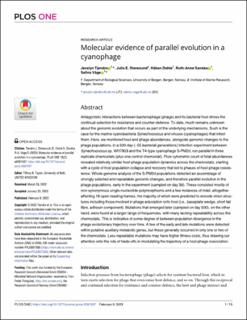| dc.description.abstract | Antagonistic interactions between bacteriophage (phage) and its bacterial host drives the continual selection for resistance and counter-defence. To date, much remains unknown about the genomic evolution that occurs as part of the underlying mechanisms. Such is the case for the marine cyanobacteria Synechococcus and viruses (cyanophages) that infect them. Here, we monitored host and phage abundances, alongside genomic changes to the phage populations, in a 500-day (~55 bacterial generations) infection experiment between Synechococcus sp. WH7803 and the T4-type cyanophage S-PM2d, run parallel in three replicate chemostats (plus one control chemostat). Flow cytometric count of total abundances revealed relatively similar host-phage population dynamics across the chemostats, starting with a cycle of host population collapse and recovery that led to phases of host-phage coexistence. Whole-genome analysis of the S-PM2d populations detected an assemblage of strongly selected and repeatable genomic changes, and therefore parallel evolution in the phage populations, early in the experiment (sampled on day 39). These consisted mostly of non-synonymous single-nucleotide-polymorphisms and a few instances of indel, altogether affecting 18 open-reading-frames, the majority of which were predicted to encode virion structures including those involved in phage adsorption onto host (i.e., baseplate wedge, short tail fibre, adhesin component). Mutations that emerged later (sampled on day 500), on the other hand, were found at a larger range of frequencies, with many lacking repeatability across the chemostats. This is indicative of some degree of between-population divergence in the phage evolutionary trajectory over time. A few of the early and late mutations were detected within putative auxiliary metabolic genes, but these generally occurred in only one or two of the chemostats. Less repeatable mutations may have higher fitness costs, thus drawing our attention onto the role of trade-offs in modulating the trajectory of a host-phage coevolution. | en_US |
